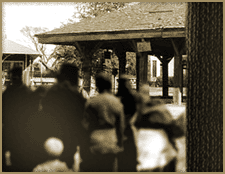







 |
 |
 |
 |
 |
| |
Did all enslaved people in the United States come from Africa?
No. All of those enslaved in the United States did not come from Africa. Before those enslaved were brought from Africa, some early settlers in North America tried to enslave the local people who were living here. These Native Americans, because they knew the land so well and because they usually had families nearby, were often able to escape to their own people. Some simply refused to work. Others died in captivity or were killed when they tried to escape. In South America, the Spanish and Portuguese colonizers enslaved many native people.
In the 1600s and early 1700s, many white men and women were brought here as "indentured servants." They were not enslaved for life, but they were not free either. They came with a document called an indenture. This was a written contract that said that they would have to serve, without pay, for a certain number of years. Like those who were enslaved, they could be beaten. They were not allowed to marry. They were not free to leave before the end of their term of service, often 5, 7 or 10 years. However, unlike enslaved persons, when their term of service was completed, indentured servants became free. They could then move wherever they wanted to go and receive pay for their work.
Most enslaved persons in America did come from Africa. The majority of those enslaved who were brought to North America came from West Africa. They were captured and sold to slave traders. They were forced onto ships for the long journey to America. This journey is often called the "middle passage."

Large crowds of people gathered at platforms in the middle of town to watch the auction.
|
Once they reached this country, men, women, and children were sold. Enslaved people were often sold in auctions held right on a public street. People interested in buying these men, women, and children would come and look at them, often poke at them, and generally figure how much work they could do. Men who could do heavy work were sold for the most money. These auctions were terrible times for those who were enslaved. Often they were the last time they ever saw their families.
A large number of enslaved persons who were born in Africa did not come directly to the English colonies or, later, the United States. Many people first spent some time on islands in the Caribbean before being brought here. Owners often purchased enslaved people from different parts of Africa. Because they spoke different languages, they could not communicate well with each other. This made it easier for the owners to control them.
In 1807, the United States Congress outlawed the foreign slave trade. The law prohibited importing any more people from Africa or the Caribbean. That would mean that, in the future, all enslaved people would be native born. However, the law was not well enforced, and some people continued to be captured and brought here directly from Africa and from islands in the Caribbean.
Were all Africans enslaved people?
« back to Slavery and Free Blacks
|
|
 |
 |
 |
|
 |
|










